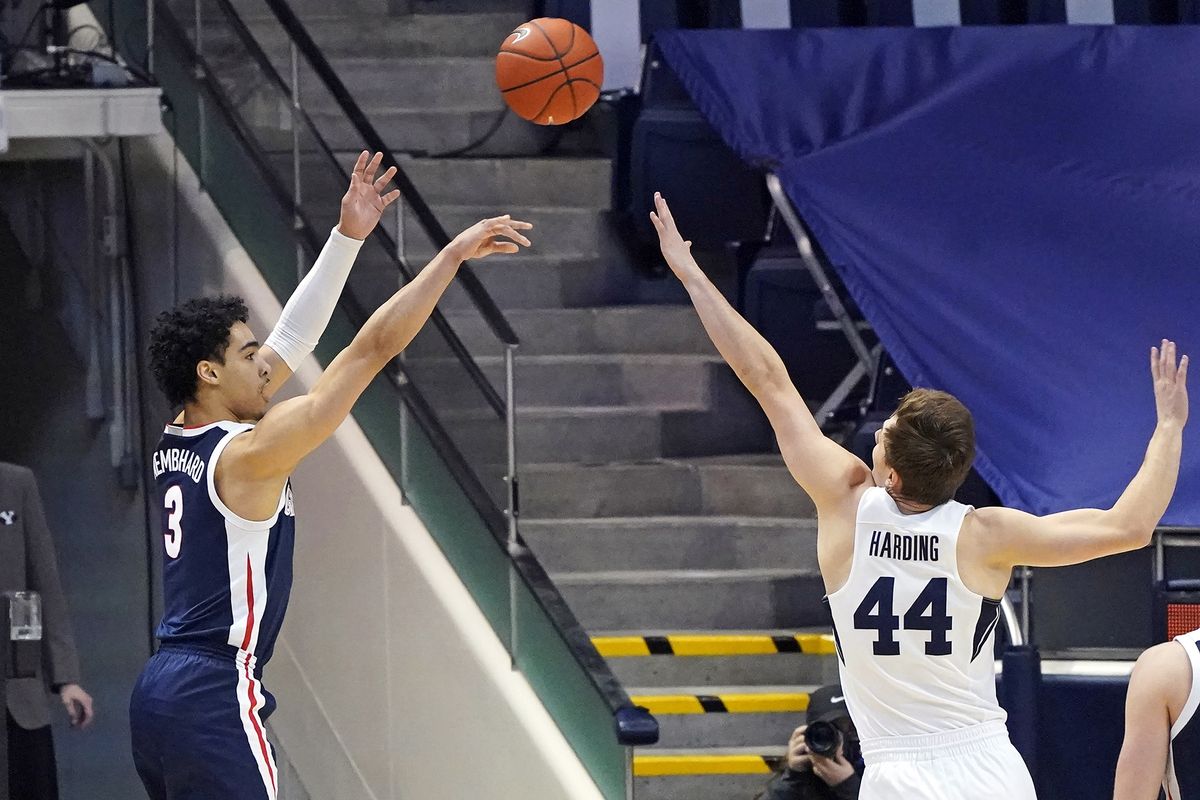Potential shortcomings in short supply for unbeaten Gonzaga

Time to scratch the noggin and do some deep thinking.
No. 1 Gonzaga (19-0) has handled every opponent on its schedule with a record-setting offense and an improving defense. Many college basketball gurus have all but penciled the Bulldogs and No. 2 Baylor onto the last two lines of the NCAA Tournament bracket.
Tough to argue against that, frankly.
Gonzaga has been dominant and the fan base’s handwringing has been relatively minimal, limited to occasional slow starts or ragged finishes, shaky defensive stretches or errant 3-point efforts.
Finding substantial shortcomings in Gonzaga’s game is nearly as difficult as beating the Zags, but there are potential concerns to keep an eye on with Selection Sunday just over a month away.
Shooting range
Gonzaga ranks high in most offensive statistics except one – 3-point accuracy.
The Zags check in at 34.9%. That’s the lowest percentage in coach Mark Few’s 22 seasons. The 2010 squad made 35.3%. The next lowest: 36.4% in 2000 and 2006.
The catch, of course, is the Zags don’t rely on the 3-ball. They edged West Virginia with just four 3s, one of five games they’ve won with that total. Gonzaga has been sub-30% from 3 six times. Average margin of victory: 20.2 points.
According to Hoop-math.com, 49.1% of Gonzaga’s field-goal attempts are categorized as “at the rim” and they make nearly 74%. GU is connecting on 64.2% inside the arc.
The bigger concern is the streaky nature of Gonzaga’s 3-point shooters other than Kispert’s 48.3% clip. Most foes tend to sag off Drew Timme and Anton Watson when they’re beyond the arc and go under screens on some of the guards to dedicate more attention in the paint. Still, few have been able to slow the Zags’ ball-screen packages.
Jalen Suggs has the second-best 3-point percentage (36.7) among regulars, followed by Timme and Joel Ayayi at 33.3% and Andrew Nembhard at 30%. Suggs has dialed it up against tougher competition, including 2 of 3 vs. Kansas, 7 of 10 against Iowa and 3 of 7 in two wins over BYU.
Rim protection, frontcourt depth
After a handful of early shootouts, the Zags have buckled down on defense. They’re proficient in field-goal percentage defense (41.4), win the glass by 8.1 per game and thrive on the combination of forcing turnovers/steals that fuel their transition game.
Gonzaga has made a steady climb up KenPom’s defensive efficiency rankings to its current standing at No. 5.
GU has done it despite limited rim protection. The Zags rank eighth in the West Coast Conference with three blocks per game, tied for 187th nationally.
The Zags don’t have a bunch of big bodies playing major minutes, even with Oumar Ballo’s return from a thumb injury. It underscores the importance of avoiding foul trouble.
Timme has been one of the nation’s best frontcourt scorers, but he’s also made noticeable defensive strides. He hasn’t committed more than two fouls in a game since Dec. 29. He’s played at least 27 minutes in eight of 10 contests during that span.
“It’s an area that I needed to grow,” Timme said after Monday’s win over BYU. “You can’t double (team) all the time. I’m really proud of myself and the progress I’ve made, but I still have a long way to go.”
Gonzaga’s defense can’t match the offense’s sparkling stats, but its played a role in those frequent 90-point performances.
“We’re at our best when we’re into the ball, especially when we have guys like Jalen and Andrew,” Few said. “I don’t know if they’re riverboat gamblers, but they understand the game and when they can press up and break on some balls. Second time around playing BYU, I think they knew some of the actions and jumped it pretty good to create some things.”
Staying sharp
This is a long-time criticism of the program that grates on GU faithful. It’s based on the notion that the Zags aren’t battled-tested enough by WCC teams entering postseason play.
It resonated louder before 2015, when Gonzaga returned to the Elite Eight for the first time since 1999. The Zags followed that up with two Sweet 16s, a trip to the 2017 national championship game and another Elite Eight. Gonzaga was one of the favorites last season until the tournament was canceled by the COVID-19 pandemic.
Still, the WCC won’t be confused with the Big 12 and it’s one of the reasons Gonzaga frontloads its schedule with tough nonconference games. The Zags were particularly ambitious in November and December, taking on Kansas, West Virginia, Iowa and Virginia.
The goal was to face a variety of playing styles that Gonzaga could encounter in March. GU hasn’t ruled out lining up another marquee nonconference game.
The 2017 team won every WCC game by at least 10 points before being upset by BYU in the regular-season finale. Gonzaga then dug out three NCAA Tournament wins by six points or less en route to the championship game.